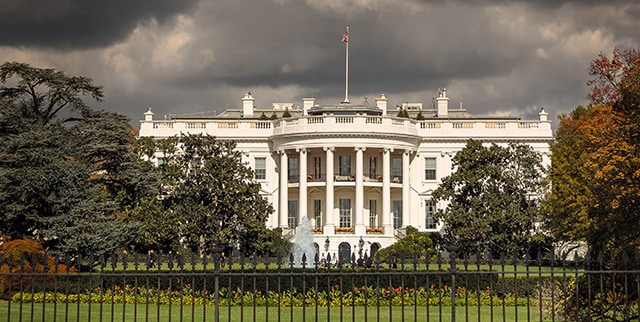A year into President Trump’s term, America’s political life has changed beyond recognition. But what has his administration meant for companies?

To assess the 45th president’s record, policy must be separated from politics. Ultimately, companies don’t care about the resignations, indictments, tweets and endless controversies of the past 12 months. Businesses will judge President Trump on policies such as tax reform and infrastructure investment; they’ll ignore fiery rhetoric about trade, in favor of understanding what is happening at ports (and in courts) across the country. We follow their lead.
Necessarily, any assessment must be partial. Government touches almost everything companies do. It’s impossible to document all the changes of the past year. Instead, we’ve focused on issues that dominated the campaign and most affect US and international companies. While some might think any assessment is premature, the president has been quick to claim economic and trade victories. We’re happy to use his own benchmarks.
Tax Reform

Trump describes his tax proposals, launched in September and facing a battle to get through Congress, as “pro-growth, pro-jobs, pro-worker, pro-family and pro-American.” They’re certainly pro-business: Corporate tax would fall from 35% to 20%—benefiting all companies active in the US, whether domestic or foreign—while a new territorial system would exempt US corporations’ foreign earnings from US tax. At the same time, various loopholes and exceptions would be eliminated to help simplify the tax system (and partly fund the cuts). For example, the proposals include a 20% tax on cross-border transactions between companies’ business units, designed to reduce abuse of transfer pricing; some tax experts believe the change could negatively impact European multinationals in particular (which often pay little US tax due to tax treaties and diversion of their US earnings to low-tax jurisdictions).
“The US statutory tax rate on corporate income is too high compared to other developed economies—a reduction was necessary,” says Eric Toder, fellow at the Urban Institute and co-director of the Tax Policy Center in Washington, DC. “However, these proposals are very skewed toward high-income groups and companies. Most important: By failing to broaden the tax base sufficiently, they will increase the deficit—our research shows they would reduce federal revenue by $2.4 trillion over 10 years.”
The administration follows the supply-side argument that tax cuts will generate growth and ultimately reduce the deficit. “Although the net tax changes may widen the budget deficit in the short term, the incentive effects of lower tax rates and the increased accumulation of capital will mean faster economic growth and higher real incomes, both of which will cause rising taxable incomes and lower long-term deficits,” Martin Feldstein, professor of economics at Harvard, wrote recently.
However, this is contentious. “Reagan’s tax cuts in the 1980s, or George W. Bush’s cuts in the 2000s, failed to stimulate growth and instead just widened the deficit,” says Paul Ashworth, chief North American economist at Capital Economics in Toronto. Trump’s proposals differ from earlier plans by targeting corporate tax rates, supposedly to stimulate investment. However, Toder notes, there is already abundant corporate cash available for investment: “Interest rates are low, and companies’ profits are high.”
Similarly, the 2004 corporate tax break on overseas profits bodes ill for Trump’s plan to introduce a one-time tax on overseas cash to spur repatriation of cash and increased investment. “The 2004 measure required funds to be invested in the US,” explains Toder. “But cash is fungible: While the overseas cash didn’t go directly to shareholders, it replaced funds earmarked for investment—these were then returned to shareholders or sent back overseas.” Although the current measure is a little different in character from the 2004 measure, repatriated cash is likely to be directed toward similar ends.
Any tax bill must be passed by Congress, where Republicans are struggling to find a version agreeable to both House and Senate.
Verdict: Positive for business, if they can pass a new law, but the impact on the deficit could be profound.
International Trade

Trump campaigned in no small part on trade issues. “He was explicit: The US was being taken advantage of by its trading partners because of bad deals negotiated by past presidents,” says Gary Hufbauer at the Peterson Institute for International Economics in Washington, DC.
Trump’s main campaign proposals were to impose a 35% tariff on Mexico and a 45% tariff on China (which would be named as a currency manipulator); leave the Trans-Pacific Partnership (TPP) agreement, negotiated by Obama with 11 other countries; and “fix” NAFTA. “Of these, only TPP has occurred—although NAFTA negotiation is underway,” says Hufbauer. “That indicates a different approach in office.”
Rather than increasing tariffs, Trump is targeting sectors where US companies claim competition is unfair. “The rhetoric has changed to include export promotion,” says Hufbauer. “The US has negotiated improved access for US beef producers and rating agencies to China while launching investigations into steel and aluminum competition and China’s alleged appropriation of trade secrets. The [300%] tariff on Canadian company Bombardier, which competes with Boeing, fits the pattern.”
This emphasis on export promotion tacitly recognizes the benefits of free trade—a volte-face. One explanation may be the pickup in global trade growth to 3.6% this year; the US is especially benefiting given the dollar’s 10% decline since December 2016. Politics may also play a part. “When Trump threatened to terminate NAFTA, his agriculture secretary explained that congressional districts Trump won in the election would be worst hit,” says Hufbauer.
Despite this apparent new-found pragmatism, Trump continues to play a high-stakes game with regard to international trade. As Global Finance went to press, NAFTA negotiations had yet to conclude. Given Trump’s unpredictability, leaving the agreement remains a possibility. That would profoundly disrupt the intricate supply chains that both US and non-US companies have established in recent decades—to the detriment of international investment in the US and US jobs. The automotive sector alone could suffer a $4.4 billion fall in net income if the US withdraws from NAFTA, according to consultancy Bain & Co.
Moreover, while his actions on trade have been more measured than anticipated, trips to Japan and South Korea in November—where he excoriated his hosts over trade imbalances—and brinkmanship on NAFTA risk undermining US global influence. Trump’s domestic focus and economic nationalism have created a vacuum that China is jockeying to fill, as Germany also is, to a lesser extent. Ultimately, any diminution in the power of the US will affect its ability to set the global economic agenda and US companies’ opportunity to benefit from that position of strength.
Verdict: less dogmatic than expected, but NAFTA strategy is high risk.
Finance

Since his inauguration, Trump has tweeted more than 20 times about stock markets hitting “an ALL-TIME high!” “Markets are at record highs,” agrees Capital Economics’ Ashworth. “The S&P 500 has gone from 2,300 to 2,500.” But Ashworth says context is important: “During Obama’s first term, it went from 500 to 2,300—a 300% gain.”
Certainly, conditions are supportive for corporate fundraising. “Market activity has been impressive from a postcrisis perspective,” says Mark Brightbill, director of market development at data-provider Dealogic in New York. Corporate bond issuance is at record levels, and equity capital markets (ECM) activity has surpassed 2016 (though not the peaks of the 2000s); M&A is slightly down on 2016. “Many market participants are waiting for the tax plans to be enacted,” says Brightbill.
The drivers of activity vary. “In ECM, companies are eager to take advantage of the succession of all-time highs,” says Brightbill. “Much of the refinancing activity in debt capital markets and loan markets has been prompted by the expectation that the Fed will continue raising rates. However, underlying these strong market conditions are high levels of consumer confidence—the highest since 2000—and optimism among corporates.”
So can Trump take credit for any of this? “While it is difficult to attribute specific market performance to any single political figure, it is clear that this confidence and optimism among individuals and companies is connected to Trump’s policies,” says Brightbill.
The risk is that there’s a long way to fall if policy commitments aren’t followed through. Lindsey Bell, investment strategist at research firm CFRA in New York, says that tax reform may be baked into prices, for example. “In November 2016, the S&P 500 was valued at a price-to-earnings multiple of 16 times estimated 2017 earnings; now it’s 20 times the slightly reduced 2017 earnings estimate,” she notes.
Verdict: Trump has buoyed investor sentiment; companies have benefited.
Infrastructure
For some, only infrastructure investment can make America great again. The American Society of Civil Engineers (ASCE) estimates a $4.6 trillion backlog. “Certainly, much of America’s infrastructure was built from the 1940s to 1960s and needs replacing,” says Mike Bernier, tax partner at Ernst & Young (EY). “But it’s hard to argue that it prevents businesses operating: It’s more realistic to say that investment would benefit companies and improve US competitiveness.”
Despite being some way off $4.6 trillion, Trump’s $1 trillion infrastructure plan was well received. But details were released only in June 2017—much later than expected. “The goal is to use $200 billion of government funds to prime the pump and encourage private-sector investment, especially in otherwise marginal projects,” explains Bernier. This could be a boon for foreign infrastructure investors, who have historically found it harder to gain access to the US than to other developed countries. In the run-up to the policy launch, treasury secretary Steven Mnuchin explicitly said that “working with foreign investors [will] be a critical part of any plan.” Since then, however, we’ve heard nothing: The president’s political capital has been invested elsewhere.
“The administration chose to prioritize healthcare and tax reform, so infrastructure has fallen down the list,” says Bernier. “With $1 trillion to spend, there’s a logical deal to be done [on infrastructure investment]—in contrast to issues like Obamacare, for example, where there is a clear political divide. The risk is that Washington has now become so partisan that finding agreement on infrastructure in the second year of the administration may be impossible.”

Moreover, the White House’s emphasis on private investment—and especially on the involvement of foreign investors—could hamper progress. Many Democrats are steadfastly opposed to infrastructure investment by foreign entities, which include sovereign wealth funds (Saudi Arabia’s has pledged up to $20 billion via a Blackstone private equity fund). Given the Trump administration’s economic nationalism, it’s ironic that one of its flagship policies could be in jeopardy partly because of an insistence on foreign participation.
Verdict: There’s no detail or action; agreement may be tougher in year two.
Regulatory Reform
During the campaign, Trump regularly railed against red tape. In office he has acted, though not always in the ways promised. For example, he hasn’t repealed the postcrisis Dodd-Frank Act, but Wall Street has gained handsomely from senior administration appointments. Reforms, such as changes to systemic risk assessment that would have required banks to raise billions in new capital, have also been postponed. Some observers claim lax enforcement of out-of-favor regulations is also a key component of the Trump playbook.
To fulfill his pledge to eliminate rules that he believes hinder Main Street, Trump has established a “one in, two out” plan for regulations and a “net-zero” promise to ensure new regulatory costs are balanced with reductions elsewhere. “ ‘One in, two out’ could be more than a slogan,” says EY’s Bernier. “It could free up companies to focus on their business instead of regulation.”
The administration’s Unified Agenda of Federal Regulatory and Deregulatory Actions, published in July, revealed that the ratio of major deregulatory actions to new regulation was 16:1. Office of Management and Budget director Mick Mulvaney said the only new rule introduced in the first six months of Trump’s administration was to reduce the discharge of mercury into public sewers by dentists. In total, Mulvaney said, 860 rules have been withdrawn or reconsidered; though, he added, “None of them are very sexy,” citing an example of reduced paperwork for outdoorsmen seeking to use national parks.
Mulvaney’s comment reveals a potential downside to a number-based approach to regulatory reform: It may do little to relieve pressure on companies. “The effectiveness of the plan depends on what one new regulation is added, and what two old regulations are cut,” notes Bernier.
The long-term impact of eliminating rules must also be considered. Trump’s most clear-cut deregulatory decisions relate to the environment and energy; some may have implications for decades to come. “As regulations are repealed, such as the Clean Power Plan or the Paris climate accord, opportunities are created,” says Bernier. “It’s now easier to build a coal-powered energy plant, for example; that could result in cheaper power for businesses in the short run. However, it may not be the right decision, given the potential global [renewables] opportunities for US businesses. The increased occurrences of natural disasters, which most scientists attribute to climate change, may also have unanticipated costs for US businesses.” Similarly, the swathe of financial-sector deregulation proposed by the US Treasury in October may boost the profits of Wall Street in the short term but store up potential long-term risks. For example, while the goal of trying to increase the number of listed companies is laudable, the proposed weakening of disclosure and public-communication requirements could put investors at risk and undermine the credibility of US-listed stocks.
Verdict: Red tape is being cut; time will tell on the benefits.
Economic Growth

For many, government’s principal function—after defense—is to create economic conditions for businesses to thrive. Trump believes the US has the “best economic numbers in years” while “corporations have NEVER made as much money.” Do his claims stack up?
“The US economy has performed in line with its performance of the past five years,” says Capital Economics’s Ashworth. “Growth reached 1.2% in the first quarter of 2017 and 3% in the second quarter. Employment growth to August was weaker than last year. Although it has been trending down, there has been no underlying change. The unemployment rate is low, but it was when Trump entered the Oval Office: It fell from 10% to 4.5% under Obama and from 4.5% to 4.2% under Trump.”
However, corporate earnings are growing faster than during the first half of 2016: 66% of the S&P 500 is showing top-line growth, according to CFRA’s Bell. “Part of that comes from the 8% decline in the dollar’s value since the election. Some S&P 500 constituents with operations overseas have received as much as a 1% top-line benefit,” says Bell. “However, only 43% of the index has overseas sales. Many gains are therefore from the stronger domestic economy.”
Is Trump responsible for this upswing? “Firstly, we usually assume that policies take roughly a year to affect economic statistics,” says Ashworth. “Secondly, in the case of Trump, there are no policy changes of substance that could have had a bearing on the economy to date.” Instead, economic buoyancy may be attributable to momentum. “Economies grow naturally as the population grows and technology increases productivity,” he explains.
Hazards are looming, because supply constraints such as low unemployment will eventually feed through to higher inflation, says Ashworth. “Regardless of who is in office, the economy most likely has 18 months more expansion before we can expect a regular cyclical economic downturn—and it’s important to note Trump will not have been responsible for that either.”
Verdict: The figures look good, but it’s difficult to credit Trump (yet).
Time for Action
During the past year, tech companies complained about the reform of the H-1B visa program for skilled foreign workers, the renewables lobby opposed the US exit from the Paris agreement on climate change, and big business made a rare political intervention to condemn the end of the Deferred Action for Childhood Arrivals program. But corporate America’s silent majority has kept faith with Trump because his arrival has coincided with a period of abundance.
Companies’ patience can only last so long, however. At some point, business will demand results on issues such as tax, infrastructure and deeper regulatory reform. The longer action is delayed, the greater the risk of a painful comedown. For many companies, the time for Trump to prove he’s true to his word cannot come soon enough.



